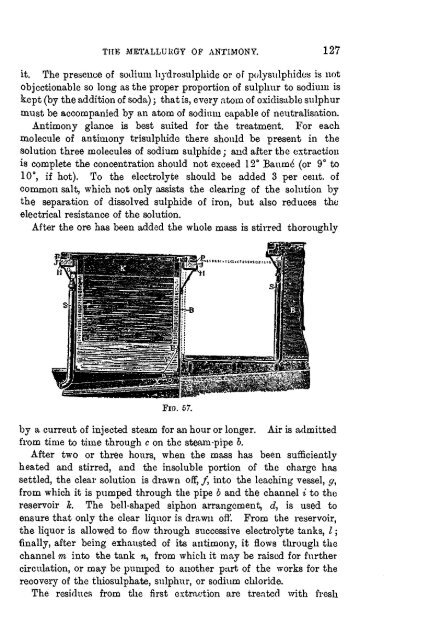antimony - Sciencemadness.org
antimony - Sciencemadness.org
antimony - Sciencemadness.org
You also want an ePaper? Increase the reach of your titles
YUMPU automatically turns print PDFs into web optimized ePapers that Google loves.
THE METALLURGY OF ANTIMONY.<br />
127<br />
it. The presence of sodium hydrosulphido or of poly sulphides is not<br />
objectionable so long as the proper proportion of sulphur to sodium is<br />
kept (by the addition of soda); that is, every atom of oxidisable sulphur<br />
must be accompanied by an atom of sodium capable of neutralisation.<br />
Antimony glance is best suited for the treatment. For each<br />
molecule of <strong>antimony</strong> trisulphide there should be present in the<br />
solution three molecules of sodium sulphide; and after the extraction<br />
is complete the concentration should not exceed 12° Baimae* (or 9° to<br />
10°, if hot). To the electrolyte should be added 3 per cent, of<br />
common salt, which not only assists the clearing of the solution by<br />
the separation of dissolved sulphide of iron, but also reduces the<br />
electrical resistance of the solution.<br />
After the ore has been added the whole mass is stirred thoroughly<br />
FIG. 57.<br />
by a current of injected steam for an hour or longer. Air is admitted<br />
from time to time through c on the steam-pipe b.<br />
After two or three hours, when the mass has been sufficiently<br />
heated and stirred, and the insoluble portion of the charge has<br />
settled, the clear solution is drawn off, /, into the leaching vessel, #,<br />
from which it is pumped through the pipe b and the channel i to the<br />
reservoir k. The bell-shaped siphon arrangement, d, is used to<br />
ensure that only the clear liquor is drawn off. From the reservoir,<br />
the liquor is allowed to flow through sxiccessive electrolyte tanks, I;<br />
finally, after being exhausted of its <strong>antimony</strong>, it flows through the<br />
channel m into the tank n, from which it may be raised for further<br />
circulation, or may be pumped to another part of the works for the<br />
recovery of the thiosulphate, sulphur, or sodium chloride.<br />
The residues from the first extraction are treated with fresh
















